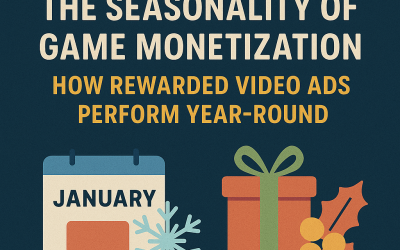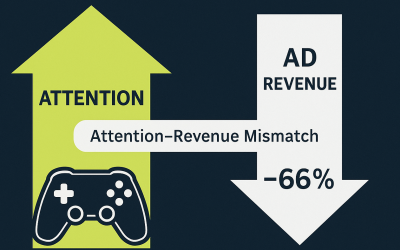7 ideas on Growing Revenue without Breaking Your Games
Growing revenue without breaking your games requires a balanced approach that prioritizes player experience. Implementing strategies like rewarded video ads, in-game purchases, subscriptions, offerwalls, and optimized ad placement can significantly boost revenue. Remember, player satisfaction should always be at the forefront of your monetization strategies. By providing value and enhancing engagement, you can achieve sustainable growth and long-term success.
In this post, I will try to review 7 strategies Game developers can use to grow revenue without excessively impacting user experience!
[ez-toc]
-
Contents
Implement Rewarded Ads
Rewarded video ads are a win-win for both developers and players. Players watch short video ads to earn in-game rewards such as extra lives, coins, or power-ups. This method enhances user experience by providing value and increases engagement. For developers, it boosts ad revenue significantly. Platforms like Unity and AppLixir offer seamless integration of rewarded video ads, ensuring a smooth user experience.
Key Points to consider here include:
- Non-intrusive and Voluntary: One of the biggest advantages of rewarded video ads is that they are completely voluntary. Players have the choice to watch an ad to earn rewards, rather than being forced to view one. This non-intrusive approach respects the player’s time and autonomy, which can lead to a more positive gaming experience. Unlike other ad formats that can interrupt gameplay, rewarded video ads are typically offered at strategic points, such as after completing a level or during a break in the action. This integration ensures that the flow of the game is not disrupted, maintaining a seamless experience for players.
- Enhances User Experience: Rewarded video ads can significantly enhance the user experience by providing additional value. Players appreciate the opportunity to earn rewards without spending real money. This can increase their satisfaction and loyalty to the game. When players feel that they are receiving something valuable in return for their time, they are more likely to engage with the ads and continue playing the game. Additionally, the rewards earned through these ads can help players progress faster, making the game more enjoyable and less frustrating. This positive reinforcement encourages continued engagement and can lead to higher retention rates.
- High Engagement Rates: Rewarded video ads boast high engagement rates compared to other ad formats. Because players voluntarily opt-in to watch these ads, they are more likely to pay attention and engage with the content. This leads to better ad performance and higher revenue for developers. The opt-in nature of rewarded video ads ensures that the audience is genuinely interested in the rewards being offered, resulting in more meaningful interactions with the ads. This high level of engagement benefits advertisers as well, as it leads to better brand recall and increased likelihood of action. For developers, this translates to higher eCPMs (effective cost per thousand impressions) and increased overall revenue from ad placements.
-
Utilize In-Game Purchases
 Continuing on ‘7 ideas on Growing Revenue without Breaking Your Games’ post, In-game purchases, or microtransactions, are a staple in the gaming industry. They allow players to buy virtual goods, such as skins, characters, or upgrades. Ensure these purchases are optional and do not create a pay-to-win environment. Offering cosmetic items that do not affect gameplay balance is a popular strategy.
Continuing on ‘7 ideas on Growing Revenue without Breaking Your Games’ post, In-game purchases, or microtransactions, are a staple in the gaming industry. They allow players to buy virtual goods, such as skins, characters, or upgrades. Ensure these purchases are optional and do not create a pay-to-win environment. Offering cosmetic items that do not affect gameplay balance is a popular strategy.
Key Points to consider here include:
- Optional and Non-Intrusive: A key advantage of in-game purchases is that they are entirely optional. Players can choose to buy items to enhance their gameplay, but the core game remains fully accessible without spending money. This voluntary aspect ensures that players do not feel pressured or compelled to make purchases, maintaining a positive gaming experience. Non-intrusive implementation means that these purchase options are integrated smoothly into the game’s interface, allowing players to browse and buy items without interrupting their gameplay. By offering a seamless purchasing experience, developers can encourage spending without alienating their player base.
- Avoids Pay-to-Win Scenarios: One of the most critical aspects of in-game purchases is to avoid creating a pay-to-win environment. Pay-to-win scenarios occur when players who spend money gain significant gameplay advantages over those who do not. This can lead to frustration and resentment among non-paying players, negatively impacting player retention and overall game reputation. To prevent this, ensure that purchasable items are balanced and do not provide unfair advantages. Focus on offering items that enhance the gaming experience without disrupting the competitive balance. This can include cosmetic items, convenience features, or optional content that adds value without compromising fairness.
- Focus on Cosmetic Items: Focusing on cosmetic items for in-game purchases is an effective way to monetize without affecting gameplay balance. Cosmetic items, such as skins, outfits, emotes, and decorative accessories, allow players to personalize their characters and game environments. These items do not alter the core mechanics of the game, ensuring a level playing field for all players. Cosmetic items appeal to players’ desires for self-expression and uniqueness, encouraging them to spend money to stand out or customize their experience. Additionally, offering a wide variety of cosmetic options can cater to different player preferences, increasing the likelihood of purchases.
-
Offer Subscriptions
Subscription models can provide steady revenue streams. Offer players access to exclusive content, ad-free experiences, or special bonuses for a monthly fee. This method can enhance user loyalty and long-term engagement. It’s essential to provide value that justifies the subscription cost.
Key Points to consider here include:
- Steady Revenue Stream: Subscriptions provide a predictable and steady revenue stream, which can be more reliable than one-time purchases or ad revenue. With a recurring monthly fee, developers can better forecast their earnings and invest in continuous improvements and new content for the game. This financial stability allows for more strategic planning and resource allocation, ensuring that the game can evolve and grow over time. Subscription revenue can also cushion the impact of seasonal fluctuations and market changes, providing a more secure financial foundation.
- Enhances User Loyalty: Offering a subscription can significantly enhance user loyalty. Subscribers often feel more invested in a game because they are paying for an ongoing service. This financial commitment can translate to a deeper emotional commitment, leading to increased engagement and retention. Subscribers are likely to spend more time in the game to make the most of their investment, which can boost overall user activity and community building. Moreover, by providing regular updates, exclusive content, and special perks, you can keep subscribers excited and looking forward to new additions, further strengthening their loyalty.
- Justify the Cost with Exclusive Content: To make subscriptions appealing, it’s crucial to justify the cost with exclusive content and benefits that are not available to non-subscribers. This can include unique in-game items, early access to new features or levels, special events, and ad-free gameplay. The value provided should be clear and compelling enough to convince players that the subscription is worth the price. Transparency about the benefits and regular communication about upcoming exclusive content can also help maintain subscriber satisfaction. Highlighting the added value and ensuring that subscribers feel they are getting their money’s worth is essential for maintaining and growing your subscription base.
-
Integrate Offerwalls
 Continuing on ‘7 ideas on Growing Revenue without Breaking Your Games’ post, Offerwalls present players with various tasks or surveys to complete in exchange for in-game currency. This approach is beneficial as it provides an alternative to spending real money while still generating revenue for the developer. Ensure that offerwalls do not disrupt the gameplay experience.
Continuing on ‘7 ideas on Growing Revenue without Breaking Your Games’ post, Offerwalls present players with various tasks or surveys to complete in exchange for in-game currency. This approach is beneficial as it provides an alternative to spending real money while still generating revenue for the developer. Ensure that offerwalls do not disrupt the gameplay experience.
Key Points to consider here include:
- Alternative to Spending Real Money: Offerwalls provide players with an alternative way to earn in-game currency or rewards without having to spend real money. This can be particularly appealing to players who are reluctant or unable to make purchases but still want to progress or enjoy the game’s premium features. By completing tasks, surveys, or downloading and trying other apps, players can earn the currency they need. This method expands your monetization strategy by including players who prefer to engage with offers rather than make direct purchases, ensuring that a broader audience can contribute to your revenue.
- Non-Disruptive Integration: A key benefit of offerwalls is that they can be integrated into the game in a non-disruptive manner. Unlike some ad formats that can interrupt gameplay, offerwalls are typically accessed through a dedicated section of the game, such as a menu or store tab. Players can choose to visit the offerwall and complete tasks at their convenience, ensuring that their core gameplay experience remains uninterrupted. This voluntary engagement respects the player’s control over their gaming experience, fostering a positive perception of the game’s monetization methods. Additionally, a well-designed offerwall interface can seamlessly blend with the game’s aesthetics, maintaining a cohesive user experience.
- Generates Additional Revenue: Offerwalls can generate significant additional revenue by diversifying your income streams. They complement other monetization strategies like in-game purchases and ad placements, providing a holistic approach to revenue generation. Each completed offer translates into earnings from advertisers, adding a valuable revenue layer without relying solely on direct player spending. Moreover, offerwalls often attract high engagement rates as they provide tangible rewards, which can increase overall user activity and time spent in the game. This can have a positive impact on other monetization areas as well, such as boosting ad impressions and encouraging in-game purchases through enhanced engagement.
-
Leverage Cross-Promotion
Cross-promotion involves promoting your other games within your current game. This strategy helps in retaining users within your game ecosystem and can increase the overall revenue. Partnering with other developers for cross-promotional activities can also be beneficial.
Key Points to consider here include:
- Retains Users within the Ecosystem: Cross-promotion helps keep players engaged within your gaming ecosystem by introducing them to other games you have developed. When players enjoy one of your games, they are more likely to be interested in trying out your other titles. By strategically promoting these games, you can retain users who might otherwise leave after finishing or losing interest in one game. This strategy extends the lifetime value of each player by keeping them within your suite of games, thereby maximizing engagement and loyalty. Additionally, creating a unified brand experience across your games can strengthen player attachment and brand recognition.
- Increases Overall Revenue: By encouraging players to try multiple games within your portfolio, you can significantly increase your overall revenue. Each game represents a new opportunity for monetization through in-game purchases, ads, and subscriptions. Cross-promotion helps to distribute the monetization potential across different titles, creating a more robust revenue stream. For example, if a player spends on in-game purchases in one game, they might be inclined to do the same in another game they enjoy. This interconnected monetization strategy can amplify your earnings as players transition smoothly between your games, leveraging their established trust and satisfaction with your brand.
- Potential for Partnerships: Cross-promotion also opens up opportunities for partnerships with other developers. By promoting each other’s games, you can reach new audiences and expand your user base. Partnerships can involve reciprocal promotion, where both parties benefit from increased exposure and user acquisition. For instance, you can exchange in-game ad spaces or feature each other’s games in recommendation sections. These collaborations can be mutually beneficial, especially if the partnered games share a similar target audience. Moreover, working with reputable partners can enhance your credibility and introduce your games to players who may not have discovered them otherwise.
-
Optimize Ad Placement
Continuing on ‘7 ideas on Growing Revenue without Breaking Your Games’ post, Strategic ad placement is crucial. Ads should be placed in natural breaks within the game, such as between levels or during loading screens. Avoid interrupting gameplay with ads, as this can frustrate players and lead to lower engagement. Testing different placements can help identify the most effective spots.
Key Points to consider here include:
- Place Ads in Natural Breaks: One of the best practices for ad placement is to integrate ads into natural breaks within the game. Natural breaks are moments when the gameplay pauses or transitions, such as between levels, during loading screens, or after completing a mission. These breaks provide an opportune time to display ads without interrupting the flow of the game. Players are more receptive to ads during these pauses, as they do not disrupt the immediate gameplay. This method maintains the immersion and enjoyment of the game while still providing opportunities for monetization.
- Avoid Interrupting Gameplay: Interrupting gameplay with ads can frustrate players and lead to a negative experience. Ads that pop up unexpectedly or forcefully in the middle of action can disrupt the flow and immersion, causing players to disengage. To maintain a positive player experience, avoid placing ads during critical gameplay moments, such as during intense battles or timed challenges. Instead, position ads in areas where players expect a pause or transition.
- Test Different Placements: Testing different ad placements is essential to find the optimal spots that maximize both revenue and player satisfaction. A/B testing various ad positions and formats can provide valuable insights into what works best for your audience. Monitor key metrics such as ad engagement rates, player retention, and overall user satisfaction to evaluate the effectiveness of different placements.
-
Enhance Player Retention
The longer players stay engaged with your game, the more opportunities you have to monetize. Focus on creating high-quality content, regular updates, and engaging gameplay to enhance player retention. Loyalty programs and regular events can also keep players coming back.
Key Points to consider here include:
- High-Quality Content: The foundation of player retention is high-quality content. This means developing a game that is not only fun and engaging but also polished and bug-free. High-quality content includes compelling storylines, well-designed characters, intuitive controls, and visually appealing graphics. Players are more likely to stay engaged with a game that offers a seamless and enjoyable experience.
- Regular Updates: Regular updates are crucial to keeping your game fresh and engaging. By consistently adding new content and features, you give players reasons to return to the game. Updates can include new levels, characters, quests, events, and gameplay mechanics.
- Loyalty Programs: Loyalty programs reward players for their continued engagement and encourage long-term commitment to the game. By offering rewards for regular play and milestones, you can foster a sense of achievement and belonging among your players.
If you have read this far, I appreciate you .. any questions or comments, email me at info@blog.applixir.com ?




